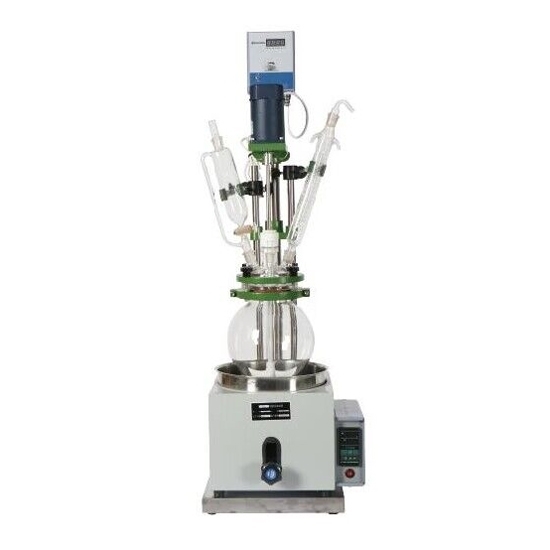
- Stock: In Stock
- Model: RDDLZ-SLGR-1L
- Weight: 1.00
- SKU: RDDLZ-SLGR-1L
Available Options
A cheap 1L single layer glass reactor fits small-scale reactions and is ideal for R&D projects or pilot plants. The versatility of single layer glass reactors extends to a wide range of applications, including pharmaceutical, chemical, petrochemical and more.
Specification
| Model | RDDLZ-LSR-1 |
| Effective Volume in the Kettle | 1L |
| Condenser Heat Exchange Area | 0.1 m2 |
| Constant Pressure Funnel Volume | 0.25L |
| Recovery Head Volume | 0.25L |
| Glass Component Material | High borosilicate 3.3 |
| Main Frame Material | SUS304 |
| Working Temperature | -80~200°C |
| Pressure in Kettle | -0.098 Mpa |
| Stirring Motor Power | 90W |
| Speed Control Mode | Electronic speed control |
| Speed Adjustment Range | 0~1000 rpm |
| Seal Material | Fluorine rubber |
| Heating Method | Bath heating |
| Power Supply | 220V~240V |
| Frequency | 50/60HZ, 1P |
| Dimension | 1130*410*450mm |
| Weight | 40kg |
Features
- 1L single-layer glass reactor adopts new high borosilicate glass, which has excellent stability and corrosion resistance.
- Digital display frequency conversion speed control, stirring speed can be adjusted, and temperature control is accurate.
- Single-layer glass reactor assembly adopts fluorine rubber seal to maintain the high precision seal under working conditions.
- Modular design, easy to assemble, easy to upgrade and maintain.
- Stainless steel frame, good stability.
- Single-layer glass reactors can be customized according to customer requirements.
Applications
The glass-lined reactor finds application in various industries, serving as a versatile vessel for chemical reactions and processes due to its corrosion resistance and thermal stability. It is widely employed in the pharmaceutical, petrochemical, and food industries, among others.
Tips: How does a glass-lined reactor work?
A glass-lined reactor is a type of chemical reactor that features a glass lining on the interior surface of the vessel. The glass lining provides protection against corrosion, chemical attack, and contamination, making it suitable for a wide
range of chemical processes.
The basic working principle of a glass-lined reactor involves the following steps:
- Charging: The process begins by charging the reactor with the desired reactants, such as liquids, gases, or solids. The reactants are typically added through an opening at the top of the reactor, which is equipped with appropriate fittings, valves, and connections.
- Mixing: Once the reactants are added, agitation or mixing is initiated to ensure uniform distribution and interaction. Agitation can be achieved through various means, such as mechanical stirrers, impellers, or gas spargers, depending on the specific requirements of the process.
- Heating or Cooling: If the reaction requires specific temperature control, the glass-lined reactor is equipped with a heating or cooling system. Heat transfer fluids, such as steam, hot water, or chilled water, circulate in the jacket or coil surrounding the glass-lined vessel to provide the necessary temperature adjustments.
- Reaction: As the reactants are mixed and heated or cooled to the desired conditions, the chemical reaction takes place inside the glass-lined reactor. The glass lining acts as a protective barrier, preventing the corrosive or reactive nature of the reactants from affecting the integrity of the metal shell.
- Monitoring and Control: During the reaction, various parameters, such as temperature, pressure, pH, and concentration, are monitored to ensure the process proceeds according to the desired specifications. Control systems, including sensors, probes, and automation equipment, help maintain the required conditions and make adjustments if necessary.
- Product Removal: Once the reaction is complete, the product is typically removed from the glass-lined reactor. This can be done by draining the contents through appropriate outlets or using specialized equipment such as discharge valves, pumps, or filtration systems.
